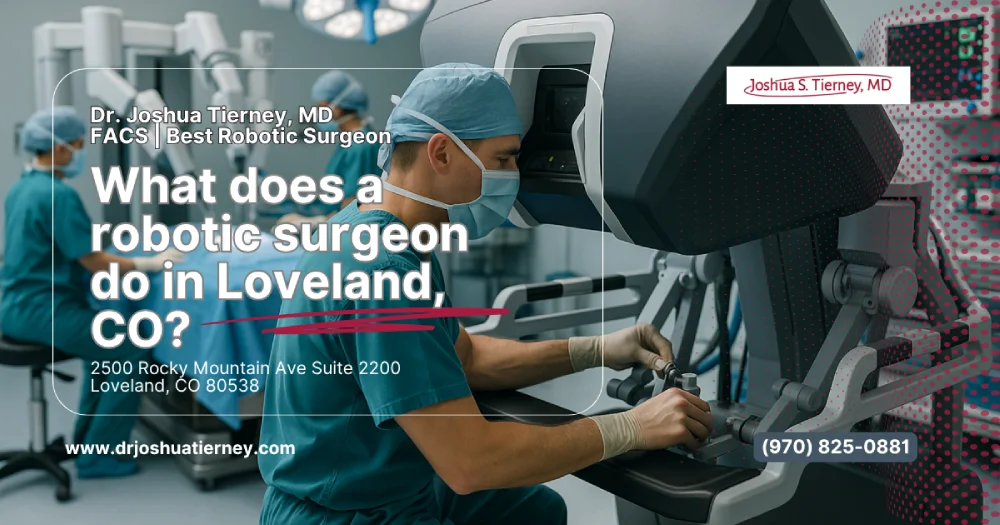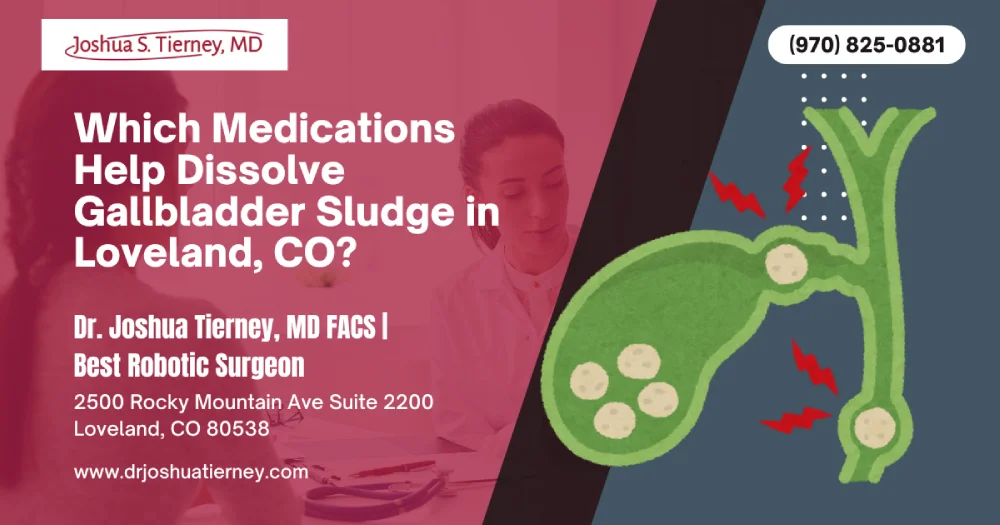Robotic surgery in Loveland, CO can vary in duration depending on the specific procedure and its complexity. Simple procedures may take as little as 30 minutes, while more complex ones can take several hours, potentially exceeding five hours in some cases. In most situations, robotic technology helps surgeons work with greater precision, which can actually shorten operating time compared with traditional open surgery.
Still, every case is different. Below, you’ll find a detailed breakdown of what truly determines the clock on the operating room wall and what that means for you as a patient or caregiver.
Key Takeaways
- Procedure type and complexity matter most. A straightforward robotic hernia repair might clock in around 45–60 minutes, whereas a multi-site cancer resection can easily span four to five hours because of added setup, imaging, and reconstruction steps.
- Experience of the surgical team in Loveland is a time-saver. Surgeons who perform hundreds of robotic cases yearly spend less time docking the robot and switching instruments, trimming 15–30 minutes off comparable procedures done by less-experienced teams.
- Hospital workflow influences the schedule. McKee Medical Center, Poudre Valley Hospital, and UCHealth Medical Center of the Rockies all use dedicated robotic suites, reducing turnover delays between cases; in community hospitals without these efficiencies, start times can slip by 30 minutes or more.
- Patient factors can add or subtract minutes. Prior abdominal surgeries, higher body mass index, or unique anatomy can lengthen dissection time. Conversely, healthy, low-BMI patients with no scar tissue often finish on the shorter end of the published averages.
- Pre-op and recovery time aren’t part of “skin-to-skin.” Expect an additional 60–90 minutes for anesthesia induction and robotic setup before the first incision, plus another 30–45 minutes in the post-anesthesia unit before heading home or to an inpatient bed.
Factors That Influence Robotic Surgery Time in Loveland, CO
Robotic surgery time isn’t a single number—it’s a range shaped by several moving parts unique to Northern Colorado’s hospitals, surgeons, and patients. Understanding each factor helps you set realistic expectations and plan your day.
Surgical Complexity, Anatomy, and Incision Strategy
Even with state-of-the-art da Vinci systems, the difficulty of the operation rules the clock. Removing a small gallbladder differs hugely from repairing a complex ventral hernia with mesh. Endoscopic suturing, lymph-node dissections, or critical care considerations can prolong console time. Larger or multiple incisions may require additional instrument exchanges, and any unexpected bleeding must be controlled in real-time for safety.
Team Experience, Certification, and Workflow
Loveland’s high-volume surgeons often hold the designation “board-certified in general surgery,” meaning they have fulfilled every guideline for skill and continuing education. Because of repetition and a finely tuned care team, they spend less time docking the robot, swapping instruments, and completing critical steps. Meanwhile, newer teams may add 15–20 minutes simply from slower console transitions or longer pauses to confirm anatomy.
Hospital Resources and Surgical Services
Dedicated robotic suites at McKee Medical Center on Boise Ave and the high-acuity intensive care unit at Poudre Valley Hospital mean no waiting for equipment. Smaller facilities that wheel the robot between rooms can create start-time creep. In-room fluoroscopy, 3-D imaging, and on-site pathology—often available in larger Colorado medical centers—also streamline decision-making, saving minutes that add up across a long surgical procedure.
Patient-Specific Factors and Health Care Needs
Scar tissue from earlier surgeries, obesity, unmanaged diabetes, or unexpected anatomical variations can stretch operating time. Conversely, straightforward anatomy, prior weight loss, and good overall patient care compliance speed things up. Because robotic systems amplify motion by a factor of ten, even subtle visceral fat differences can change the robot’s angles and compel the surgeon to re-dock, adding precious minutes.
Insurance Plan Logistics and Medical Records
It may sound administrative, but if your insurance plan authorization or outside medical records are incomplete, your case can be bumped down the board. Loveland clinics encourage you to sign all forms and send imaging files well in advance. That way, the OR schedule runs on time, and you avoid delays that might otherwise carry over into operating hours.
Average Robotic Procedure Times in Loveland
| Robotic Procedure | Average “Skin-to-Skin” Time | Common Add-Ons | Total OR Time (Incl. Anesthesia) |
| Cholecystectomy (Gallbladder) | 45–75 minutes | Intraoperative cholangiogram (10–15 min) | 90–120 minutes |
| Inguinal Hernia Repair | 30–60 minutes | Bilateral repair (+15 min) | 75–105 minutes |
| Prostatectomy | 2.5–3.5 hours | Lymph-node dissection (+30 min) | 4–5 hours |
| Hysterectomy | 1.5–2 hours | Endometriosis excision (+20–40 min) | 3–4 hours |
| Colon Resection | 3–4 hours | Anastomosis leak test (+10 min) | 4–5.5 hours |
Skin-to-skin = first incision to final suture.
Typical Durations for Popular Robotic Procedures
Robotic Gallbladder Removal
Most Loveland gallbladder cases finish in under an hour of console time. The surgical specialist uses wristed instruments to peel the gallbladder neatly off the liver, minimizing bleeding and post-operative discomfort. If your surgeon adds an on-table X-ray to check bile ducts, tack on fifteen extra minutes. Outpatient discharge is common, and recovery time back to full diet is usually just a couple of days.
Robotic Hernia Repair
A single-side inguinal hernia is the sprint of robotic surgery—often 30–45 minutes. Bilateral or larger ventral repairs take longer due to mesh placement and extensive suturing. Because the approach is minimally invasive, most patients experience faster recovery, lower pain-medication needs, and a quicker return to daily activities compared with open repairs.
Robotic Prostatectomy
Expect around three hours of console time when the urologic surgeon aims to spare nerves, control vessels, and reconstruct the bladder neck. Lymph-node removal for cancer staging can tip the total toward the four-hour mark. Despite the length, the procedure typically results in less blood loss, less discomfort, and earlier removal of the urinary catheter thanks to precise robotic suturing.
Robotic Hysterectomy
Loveland gynecologic surgeons routinely finish in roughly two hours. Extensively scarred endometriosis cases may add half an hour because of complex adhesions. Many patients meet discharge criteria the same day or after a single inpatient night, demonstrating the power of minimally invasive surgery for shorter rehabilitation time.
Robotic Colon Surgery
Segmental colectomies average three to four hours, with total OR time occasionally reaching five and a half hours when additional cancer staging or adhesion takedown is needed. Mobilizing the bowel, vessel division, and intracorporeal anastomosis are meticulous steps, especially if prior surgeries created scar tissue. Pain control remains easier, and ambulation within 24 hours is now a standard guideline for enhanced patient care.
What Happens Before, During, and After: Your Time Commitment Explained
Preoperative Phase (60–90 minutes)
- Check-in & paperwork – 15 minutes
- IV placement, anesthesia review, and confirmation of medical records – 15–20 minutes
- Anesthesia induction in the OR – 20–30 minutes
- Robot docking & sterile prep – 15–25 minutes
During this window, your multidisciplinary care team verifies your medication list, allergies, and any critical care considerations such as cardiac clearance. By following your surgeon’s NPO guideline and bringing your insurance card, you prevent logistic roadblocks that could postpone incision time.
Intraoperative Phase (Variable)
Skin-to-skin time starts with the first incision. Docking adjustments happen if the team needs different angles or real-time imaging. Instrument changes can add brief pauses, yet the precise motion of robotic arms usually saves cumulative minutes over traditional laparoscopy. If bleeding occurs, the robot’s 3-D magnification allows faster control and reduces the risk of transfusion, which might otherwise prolong surgery.
Postoperative Phase (30–45 minutes in PACU)
- Wake-up: Anesthesiologist reverses sedation.
- Vitals stabilization: Nurses monitor pain, nausea, and breathing.
- Discharge criteria: You’ll need to sit up, drink fluids, and walk a few steps.
Same-day surgeries send you home; larger cases move you to an inpatient room equipped for intensive care if necessary. Proper pain control, early ambulation, and coordinated rehabilitation planning reduce complication risk and speed overall recovery time.
How to Prepare for a Smooth, Efficient Robotic Surgery
Optimize Your Health
- Maintain a healthy weight to improve visibility for the surgeon.
- Control blood sugar and blood pressure—stable vitals make anesthesia induction quicker and safer.
- Discuss smoking cessation and exercise habits with your physician to boost lung function and wound healing.
Follow Pre-Op Instructions Exactly
- NPO after midnight: Food in your stomach forces delays or cancellations.
- Bowel prep for colorectal surgeries: A clean colon lets the surgeon move swiftly and safely.
- Shower with antibacterial soap: Lowers infection risk and supports faster recovery.
Bring Organized Paperwork
Hand your medication list, allergy info, and ID to the nurse in one tidy folder. Include imaging CDs, lab results, and a copy of your insurance plan authorization. Less hunting around equals faster check-in.
Arrange Post-Op Support
Have a driver on call and prepare a resting spot at home. Outpatient discharge can happen sooner if staff know you have reliable help to monitor discomfort, pain medications, and any warning signs of complication.
Book an Appointment for Follow-Up
Your surgeon will usually see you in the clinic on Boise Ave within 7–14 days. Timely consultation allows review of pathology, incision healing, and any additional patient needs such as rehabilitation referrals.
Choosing a Robotic Surgery Provider in Loveland, CO
When selecting a provider, look for a physician or MD who is board-certified in general surgery or their respective specialty. Verify that they hold privileges at a medical center in Loveland with advanced robotic platforms and a full spectrum of surgical services—from outpatient suites to intensive care backup. Ask about:
- Annual robotic caseload (higher numbers mean sharper skills)
- Availability of real-time imaging, endoscopic equipment, and critical care teams
- Post-operative pain-management protocols for faster recovery
- Communication style and access to your care team for urgent questions
If possible, tour the clinic and operating rooms. Meeting nursing staff, viewing the da Vinci system, and clarifying your health care needs in person can ease anxiety and streamline your surgical journey.
FAQs
How soon after robotic surgery can I go back to work?
Most patients with sedentary jobs return in 3–7 days after a minor robotic procedure, thanks to the minimally invasive approach and smaller incisions. More extensive operations like colon resection may require two to three weeks off. Always follow your surgeon’s guideline for lifting limits and pain management to avoid setbacks.
What happens if the robotic equipment fails during my procedure?
Robotic systems include multiple fail-safe features. Should a technical issue arise, your board-certified surgeon can switch to conventional laparoscopy or open surgery immediately. Backup instruments and a skilled care team are always present, ensuring continued patient safety and minimal additional operative time.
Do I need different insurance approval for robotic surgery?
In most cases, your existing insurance plan covers robotic surgery if the indication meets medical necessity criteria. Verification staff at the clinic will submit documentation, including imaging and consultation notes, to secure prior authorization. Delays are rare but possible; sign consent and provide records early to avoid rescheduling.
Will robotic surgery cost more than traditional surgery?
While equipment fees can be higher, overall costs often balance out due to shorter inpatient stays, fewer complications, and faster return to work. Many Colorado insurers view robotic surgery as cost-effective when it reduces intensive care days, readmissions, or rehabilitation services.
Can an outpatient robotic surgery become inpatient?
Yes. If unexpected bleeding, pain control issues, or complication risk arises, you may be admitted overnight. Loveland medical centers keep inpatient beds on standby so that your health care needs are always met without transferring you to another facility.
How is pain controlled after robotic surgery?
The care team uses multimodal analgesia: intra-operative local anesthetic, non-narcotic medications, and selective opioids if discomfort remains severe. Because the incisions are small, many patients rely mainly on acetaminophen and NSAIDs, promoting faster recovery and reducing constipation risk.
Will a drain prolong my operating time?
Placing a surgical drain adds only 5–10 minutes but can prevent fluid buildup and reduce complication rates. Your surgeon decides in real-time based on bleeding risk, tissue planes, and your specific surgical procedure. Removal typically occurs at the first postoperative appointment.
Is robotic surgery safe for older patients?
Age alone isn’t a contra-indication. Comprehensive consultation evaluates heart, lung, and kidney function to tailor anesthesia and monitor post-op rehabilitation. Minimally invasive techniques often prove advantageous for seniors by lowering infection rates and decreasing hospital length of stay.
What if I have severe allergies to anesthesia drugs?
During pre-op consultation, the anesthesiologist reviews your medical records, allergy list, and prior reactions. Alternative agents and skin testing are available, ensuring a safe and customized plan. Clear communication prevents last-minute delays and keeps your operating schedule on track.
How soon should I schedule my follow-up appointment?
Book an appointment before leaving the hospital. Early slots—usually 7–10 days post-op—allow your physician to address incision care, pathology results, and any lingering discomfort. Timely review keeps rehabilitation on target and decreases readmission risk.









